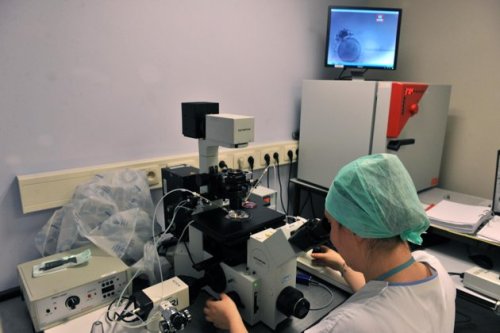WASHINGTON (AFP) - Zapping testicles with ultrasound can reduce sperm counts and might be used in the future as an inexpensive, reliable and reversible male contraceptive, according to US researchers.
Scientists from the University of North Carolina School of Medicine, who conducted experiments on male rats, issued their findings on Saturday in the journal Reproductive Biology and Endocrinology.
They said they were convinced that the method, if studied further, could be used on humans.
The team led by Doctor James Tsuruta found that by rotating high frequency
(3MHz) ultrasound around the testicles, they were able to cause depletion of germ cells throughout the testes, the reports said.
The best results were seen using two ultrasound sessions of 15 minutes, two days apart.
Saline was used to provide conductivity between the ultrasound transducer and the skin, and the testes were warmed to 37 degrees Celsius (almost 99 degrees Fahrenheit), the study noted.
The procedure reduced the sperm count to zero, the researchers said.
Fertile men in normal conditions have more than 39 million sperm when they ejaculate.
The World Health Organization has defined low sperm concentration as less than 15 million sperm per milliliter.
"Unlike humans, rats remain fertile even with extremely low sperm counts,"
Tsuruta said. "However, our non-invasive ultrasound treatment reduced sperm reserves in rats far below levels normally seen in fertile men."
He said that further studies will be required to determine how long the contraceptive effect lasts and if it is safe to use multiple times.

<한글기사>
초음파로 남성피임 가능
고환에 초음파를 발사하는 방법으로 남성피임이 가능하다는 연구결과가 나왔다.
미국 노스캐롤라이나 대학 의과대학의 소아과전문의 제임스 추루타(James Tsuru
ta) 박사는 고환 주위에 초음파를 발사하면 정자의 생산을 중단시킬 수 있다고 밝힌 것으로 영국의 BBC방송 인터넷판과 메디컬 뉴스 투데이가 30일(현지시간) 보도했다.
추루타 박사는 쥐의 고환주위에 회전고주파(3MHz) 초음파를 15분씩 두 차례 발 사한 결과 고환의 정자를 만드는 생식세포와 정자 수가 크게 줄어들었다고 혔다.
초음파는 이틀 간격으로 발사했을 때 정자 수가 가장 많이 줄었다.
이 실험에는 초음파 변환기와 피부 사이의 전도성을 높이기 위해 식염수가 사용 되었고 쥐의 고환은 온도를 섭씨 37도로 높였다.
쥐는 정자 수가 밀리미터 당 1천만 마리 이하로 줄어들었다. 사람의 경우 정자 가 밀리미터 당 1천500만 마리 이하이면 준불임(sub-fertile)으로 간주된다. 남성은 95%가 한 번 사정에 3천900만 마리 이상의 정자를 방출한다.
이 결과는 초음파가 남성피임 수단이 될 수 있음을 보여주는 것이다.
그러나 피임효과가 얼마나 오래 지속되는지, 초음파를 되풀이 사용해도 안전한 것인지, 사용 후에는 정자 수가 회복되는지, 장기간 사용하면 정자에 손상이 발생하 는 것은 아닌지 등을 확인하기 위해 앞으로 연구가 더 필요하다고 추루타 박사는 말 했다.
이 연구결과는 '생식생물학-내분비학(Reproductive Biology and Endocrinology) ' 최신호에 실렸다.





![[Herald Interview] 'Amid aging population, Korea to invite more young professionals from overseas'](http://res.heraldm.com/phpwas/restmb_idxmake.php?idx=644&simg=/content/image/2024/04/24/20240424050844_0.jpg&u=20240424200058)











![[KH Explains] Korean shipbuilding stocks rally: Real growth or bubble?](http://res.heraldm.com/phpwas/restmb_idxmake.php?idx=652&simg=/content/image/2024/04/25/20240425050656_0.jpg&u=)

